2021.06.03.5
Files > Volume 6 > Vol 6 No 3 2021
INVESTIGATION / RESEARCH
Formulation and organoleptic evaluation of Poly Herbal Cream of Punica, Neem, Carrot & Jamun as Active Ingredients
Puja Saha1*, Jayashree Bhowmick2, Anupam Saha3
Available from: http://dx.doi.org/10.21931/RB/2021.06.03.5
ABSTRACT
Assuming that herbal preparation is better with fewer side effects than synthetics, natural treatments are more effective than allopathy in terms of side effects for better human body healing. Herbal products have a growing demand in the world market, and the plants have been reported in the literature as having various pharmacological activities such as anti-microbial, anti-oxidant, anti-inflammatory activity, anti-cancer, anti-diabetic. The purpose of this study was to develop anti-aging poly-herbal cream by mixing the extract of Punica leaf, Neem Oil, Jamun powder, Carrot powder as the main ingredient, and then creams were developed based on the anti-oxidant ability of herbal extracts and performed their evaluation study. Punica granatam leaves were shade dried and extracted using the Soxhlet method with different solvents such as n-hexane, benzene, and alcohol. Fine extract powder was collected and removed distilled water thoroughly. The cream was formulated into different concentrations, namely F1, F2, F3, and F4. Similar types of research with similar components have been reported, but in this experiment, the formulation is different, and this work is kept cost-efficient and straightforward; it's an attempt to reduce few components and prepare cream and evaluate its potential. According to The International Council for Harmonization of Technical Requirements for Pharmaceuticals for Human Use ICH guidelines, the cream was stable during stability studies, and F3 turned out to be a better formulation than the other three.
Key Words: Anti-aging; Poly-herbs; Herbal Remedy; Herbal Cream; Pharmaceutical Cream; Skin Care.
INTRODUCTION
Dermal layer aging results from continual deterioration due to cellular DNA and protein; aging is classed into 2 distinct varieties: sequential skin aging and photo-aging. Each type has distinct clinical and historical options, and sequential skin aging is a universal and specific process characterized by physiological alteration in skin function. Within the aging process, keratinocytes cannot create a helpful stratum corneum, and the rate of formation from neutral lipids slows down, leading to dry pale skin with a wrinkle. In contrast, photo-aging is caused by the disorganization of stratum and dermal parts associated with physiological state and helio dermatitis. Herbs and plants have already proved helpful as a tool in the practice of medicine1–3.
Cosmetic merchandise is used to shield pores and skin in opposition to exogenous and endogenous dangerous retailers and beautify the splendor and elegance of skin and the usage of cosmetics now not only handiest growing an appealing outside look, but also towards accomplishing sturdiness of suitable fitness via way of means of decreasing skin disorders 3–8. The artificial or herbal substances found in skincare formulation that helps the health, texture, and integrity of dermis, moisturizing and preserving the pliancy of the skin with the aid of using decreasing the type I collagen, photo-protection, and plenty more, and this belongings of beauty is because of the presence of substances in cosmetics as it allows to lessen the production of loose radicals in the skin and manage the dermal residences which is the obstruction to penetrate the skin for an extended time 3,5,6. Cosmetic merchandise is the satisfactory desire to lessen dermal problems like hyperpigmentation, skin wrinkling, skin aging, problematic pores, rough skin texture, etc. The need for natural cosmetics is swiftly increasing, and the growth is because of the supply of recent ingredients, the monetary rewards for growing hitting merchandise, customer needs, and higher expertise in dermal biology3,5,9–11. The plant parts utilized in cosmetic products should have medicinal properties like anti-inflammatory, anti-oxidant, emollient, anti-seborrheic, antiseptic, anti-bacterial activities, etc. Herbal merchandise declares to have fewer adverse effects, normally visible with merchandise containing artificial agents. The marketplace studies suggest a rise in the trade with the cosmetic industries, a prime function in fueling this international call for herbals 12–14.
Punica leaf, part of the tree pomegranate. P. granatum is one of the most common and potential plants for medicine in managing various ailments 15. Punica granatum L. (belongs to the family Punicaceae) has been used to treat many ailments. Various plant parts have been scientifically tested for various pharmacological activities, such as potent antioxidative 15,16, anti-inflammatory, anti-bacterial, anti-microbial, anti-fungal properties, anti-hypertensive, and antiproliferative properties 17,18. Pomegranate has excellent potential to be developed for use in dermal products 19. Chlorophyll-a extracted from pomegranate leaf and stem may be a potential source and can supply natural or herbal colorants for the coating enterprises and nail varnish. Pomegranate leaf extracts act on inhibiting the development of obesity and hyperlipidemia in obese mice fed with a high-fat diet 20–22.
Almond oil is the oil isolated from Almonds. The almond Prunus dulcis (Mill) D.A. Webb (subfamily Prunoideae of family Rosaceae) contains fixed oil, phenolic compounds abundant in almonds; it also contains and some micronutrients, vitamins, minerals and has different pharmacological activities 23–26. Almond seeds and oil have cardio-protective, immune-stimulant effects, anti-inflammatory, and reduce irritable bowel syndrome symptoms , and they are also helpful in treating constipation 27,28. Almond oil has also been used to treat dry skin disorders like psoriasis, eczema, and many more disorders in ancient treatment cultures but today it is used in aromatherapy and for producing many skin-hair cosmetics 29.
Jamun powder is made from sun-dried Jamun Seeds. The black Jamun (Syzygium cumini L.) is an important indigenous plant of Myrtaceae, commonly known as jamun or Indian blackberry, originally from Indonesia and India, which has anti-oxidant solid antigenotoxic potential 32,33. The fruit pulp is sweet, and the seeds are acidic and sour. The presence of oxalic, gallic, tannic acids and other alkaloids creates one to feel such an astringency taste. The pulp and seeds are used for traditional medicine against diabetes, diarrhea, and ringworm infection also protect against radiation-induced sickness 32,34–37. It is very beneficial as it has anti-diabetic, cytoprotective, anticoagulant, analgesic and anti-inflammatory, anti-cancerous, anti-microbial, anti-oxidant, hypo-lipidemic, hepato-protective properties 35,38,39.
Carrots. (Daucus carota) are essentially root veggies belonging to the family of Apeaceae or Umbelliferrous. These veggies are believed to have originated approximately 5000 years ago. Carrots are to be had in diverse, colorful variations like pink, orange, white, purple, etc; however, the maximum usually observed variants are pink carrots and orange carrots. Carrots have anti-oxidants, which enables in regaining the misplaced glow of the skin. It helps in imparting remedies from scars and blemishes. Carrot is a unique anti-growing old compound due to the presence of Vitamin A.
Additionally, a considerable quantity of Vitamin C. Vitamin A acts as an excellent anti-oxidant, fights with the free radicals of the body, stabilize them, and stops them from unfavorable our pores of skin cells and accordingly prevents the symptoms of growing old like wrinkles, pigmentation, and choppy pores and skin tone. Vitamin C enables the prevention of wrinkles using assisting the manufacturing of collagen in the body, which is a crucial protein required for retaining pores and skin elasticity. Carrot is likewise a wealthy supply of β-carotenoids, which boom or trigger skin immunity in opposition to solar rays and heals sunburns 40–43.
Neem tree. (Azadirachta indica) is a local, evergreen, tropical tree to India 44. Neem is a versatile, multifarious tree with a great capacity to own the most beneficial non-wooden products. Neem has various medicinal properties, including anti-cancer properties. In India, Neem is called the village of pharmacy due to its recovery versatility, and it's been utilized in Ayurvedic medication for extra than 4,000 years because of its medicinal properties 44–47. Azadirachtin is the principal compound of the neem oil with insecticidal activity 48. Neem extracts were also reported to possess inhibitory effects on several cancer cell lines such as breast, gynecological, gastrointestinal, hematological, prostate, and skin cancers. Several active chemical compounds were discovered in neems, such as Nimbin, Nimbin, Saladin, azadirachtin (AZA), glycosides, and dihydrochalcone polyphenolics, coumarin, and tannins49–51. Pharmacological activities have been reported, including anti-bacterial, anti-inflammatory, anti-fungal, anti-arthritic, anti-pyretic, anti-gastric ulcer, hypoglycemic, and anti-tumor activities 46,49,52–54.
Grapeseed oil. is obtained from the seeds of grapes, and it was a by-product of winemaking and had many uses ranging from cooking cosmetics in controlling several diseases and wound healing potential 55–57. Vitis vinifera L., which is commonly called grape used as a food and a beverage 58. It is widely used as cooking oil, in skin care applications, and also as cosmetics. The grape seed oil contains 0.8 to 1.5% of phenols, steroids, and minor amounts of vitamin E. The grape seed oil was reported to possess the highest gallic acid, anti-oxidant, epicatechin, proanthocyanidins, catechin, and procyanidins. It has anti-oxidant, anti-fungal, anti-bacterial, antiviral, and anti-inflammatory activities 59,60.
Peppermint oil. (Mentha piperita) extracted from peppermint leaves is an excellent gastric stimulant, carminative, which has also been used in cosmetic formulations as a perfume component and a general skin conditioning agent 61,62. Peppermint (Mentha × Piperita) is a hybrid mint, which is a cross between Water mint (Mentha aquatica) and Spearmint (Mentha spicata) that is thought to be grown naturally 62,63.
Similar types of research with similar Active Pharmaceutical Ingredients API have been reported. However, in this experiment, the formulation is different, and in each formulation, peppermint oil is used as the flavoring agent, whereas in the literature review, it is found that each formulation has a different flavoring agent. This work is kept cost-efficient and straightforward, it's an attempt to omit few components and prepare cream and evaluate its potential.
MATERIALS AND METHODS
The plan of work and the procedure followed for this experiment were performed by Matangi and the team in 2014 3 . The experiment was performed in Bharat Technology, Uluberia, in 2018 as an academic project for the partial fulfillment of a Bachelor of Pharmacy degree.
Materials: Glycerin, Propylene Glycol, Zinc oxide, Micro Crystalline Cellulose, Sodium alginate, Methylcellulose, Beeswax, Sodium benzoate/paraben, Almond oil, Punica leaves, Neem oil, Jamun powder, Carrot powder, Vitamin E, Grapeseed oil, Peppermint oil, and Purified water.
Preparation of Punica leaf extract: Punica granatum leaves were bought from the market and dried. The dried leaves were ground to a fine powder in a suitable grinder mixture. Shade dried powder was extracted using a Soxhlet extractor with hexane, alcohol, and distilled water separately to get the semisolid extract. The organic solvents were then recovered by steam distillation. The extracts were then concentrated to remove wetness under reduced pressure and controlled temperature, respectively, and they were preserved in a refrigerator.
Preparation of Jamun Seeds powder: Black Jamun (Syzygium cumini L.) were bought from the market, and the seeds are separated from the freshly part of the fruit, washed adequately, and dried. The seeds were dried under the sun for a week. Seeds were pounded along with the outer skin and made into a fine powder.
Cream Formulation: The formula for the cream is given in Table No. 1.
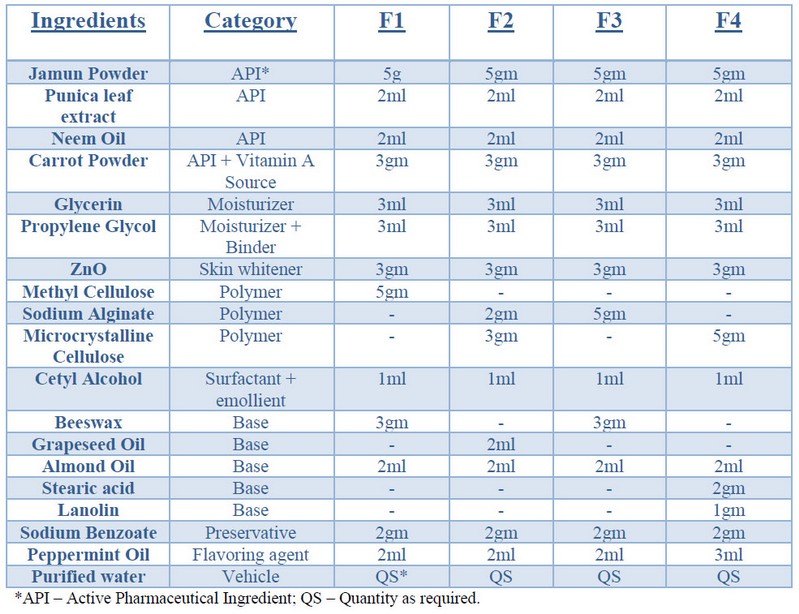
Table 1. Formulation Table
Method For Preparation Of Cream
Shade-dried Punica leaf powder was put separately in a soxhlet extractor, and then ethanol was added successively. The extracts were then concentrated under reduced pressure and controlled temperature for dryness and were stored for stabilization at a specific temperature. Glycerin was applied to the binder and polymer content, the water mixture in a beaker. This forms liquid dispersion and displays the property of slight swelling. The Punica leaf extract, neem oil, and Jamun powder were added to the liquid dispersion. Using a water bath, melted oils together with the base in a separate beaker. Skin whitener and preservative were gradually incorporated along with all other components. Triturated all ingredients above and the requisite consistency was established, which forms poly-herbal anti-aging cream.
RESULT AND DISCUSSION
Evaluation of cream: There are various evaluation parameters for cream. For this work, the evaluation parameters chosen are Organoleptic evaluation, Microbial Count test, Stability Studies, pH determination, homogeneity determination, wetness determination, smear determination, emolliency determination, viscosity determination, dilution test, dye solubility test.
Organoleptic evaluation: The cream formulated was evaluated for its organoleptic properties (color, state, and odor). The appearance of the cream was analyzed by its color and roughness visually and by touch. Results are listed in Table No. 2.
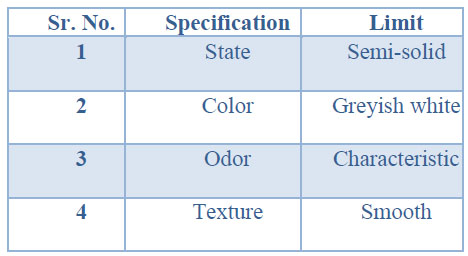
Table 2. Organoleptic Properties
Test for microbial growth in formulated creams: This method was applied from the work of Matangi and Team in the year 20143. Here, Streak Plate Method64 was used, where the formulated creams were inoculated in a plate with the Muller Hinton agar media. Along with that, a control group was made without the cream for comparison. The plates were kept in the incubator and are incubated for 24 hours at 37˚C. After the incubation period, plates were taken out and analyzed for microbial growth by comparing them with the control. Results are listed in Table 3.

Table 3. Microbial Test
Stability studies: Thermal stability testing of cream was done at room temperature with relative humidity (RH) 65%; results are listed in Table 4. To assess the drug and formulation stability for an extended period, accelerated stability studies were done according to ICH guidelines; the results are listed in Table 5.

Table 4. Thermal stability determination
Determination of Homogeneity: The formulations were tested for homogeneity by touch for texture and by visual appearance. Result obtained of each formulation is given in Table No. 6,7,8,9.
Determination of the type of smear: It was determined by applying the cream on the surface of the skin of a human volunteer (Self, no ethical permission need as it is non-toxic, natural, and safe components which makes it exceptional65. After applying the cream, the type of smear or film formed on the skin was checked. Result obtained of each formulation is given in Table No. 6,7,8,9.
Determination of Viscosity: The viscosity determinations were carried out using a Brookfield viscometer (DV II + Pro model) using spindle number S-64 at 20 rpm at a temperature of 25°C. Result obtained of each formulation is given in Table No. 6,7,8,9.
Determination of pH: Accurately weighed 1gm of the sample was dispersed in 100 ml of water. The pH of the suspension was set at 27°C using a digital pH meter. Result obtained of each formulation is given in Table No. 6,7,8,9.
Spread ability Test: This method was applied from the work of Dhase and Team in the year 2014, Chen and Team in the year 2016 66,67. Spread ability can be expressed by the extent of the area to which the topical application spreads when applied to the affected parts on the skin and the curative value of the formulation also hang-on upon its spreading value. Hence, it was found obligatory to determine the spread ability of the formulation. For this purpose, a small amount of about 23cm of each formulation was applied in between two glass slides, and they were pressed together to obtain a film of uniform thickness by placing 1000gm weight for 5 minutes. Thereafter a weight of 10gm was added to the pan, and the top plate was subjected to pull with the help of string attached to the hook. The time in which the upper glass slide moves over the lower plate to cover a distance of 10 cm was noted. The Spread ability (S) can be determined using the formula 66,67.
S= (m × L)/T,
Where S–Spread ability;
m - Weight binds to the upper glass slide,
L - Length budged on a glass slide
T - Time is taken.
Results obtained are given in Table No. 10. The cream was found to be easily spreadable.
Dye solubility test: This method was applied from the work of Dhase and Team in the year 201466. In this test, a small sample is mixed with a water-soluble dye and observed under the microscope. If the continuous phase appears red, the cream is O/W (Oil in Water) type as the water is in the external phase, and the dye will dissolve in it to give color. If the scattered globules appear red and continuous phase colorless, they are W/O (Water in Oil) type. Likewise, if an oil-soluble dye such as Scarlet red or Sudan III is put on to an emulsion and the continuous phase appears red, it is w/o emulsion. Following the procedure, red color was observed; hence, it was O/W type of cream 66.
Dilution test: This method was applied from the work of Dhase and Team in the year 201466. In this test, the cream is diluted either with oil or water. If the cream is o/w type and diluted with water, it will remain stable as water is the dispersion medium, but if it is diluted with oil, the cream will break as oil and water are not miscible. Oil in water emulsion can be diluted with an aqueous solvent, whereas water in oil emulsion can be diluted with an oily liquid. Following the procedure, it was found to be O/W type of cream as because the obtained product was stable 66.
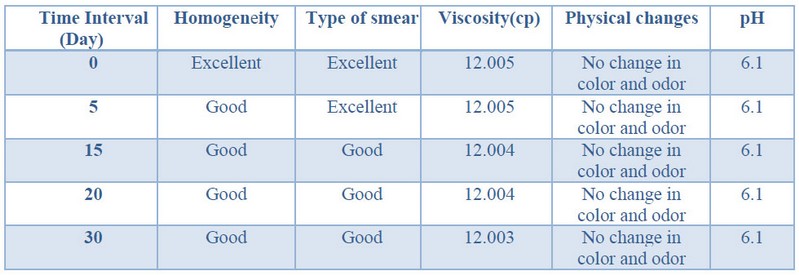
Table 6. Formulation 1

Table 7. Formulation 2
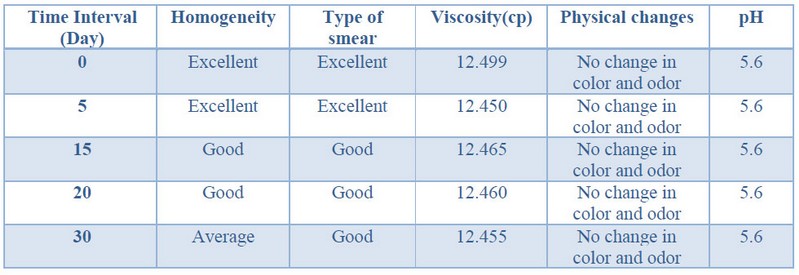
Table 8. Formulation 3
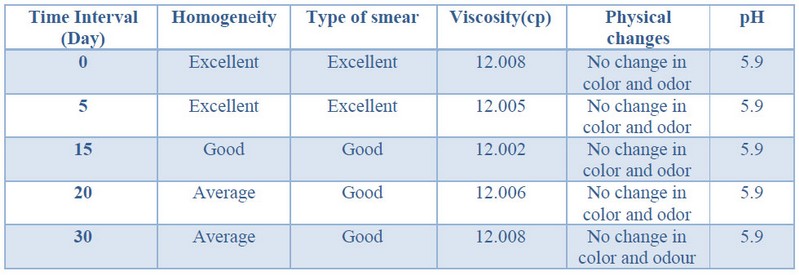
Table 9. Formulation 4
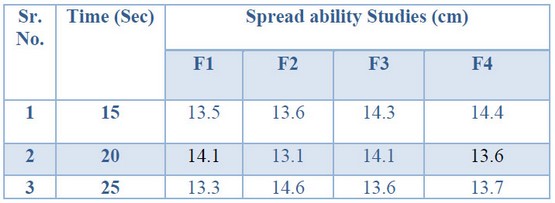
Table 10. Spread ability Test
The cream was the o/w type of emulsion. Due to the base material, the proper addition of surfactants to its proper quantity, and the proper combination of all the excipients, it was stable. The proper ratio of all ingredients of excipients with the active ingredients also reasons for the stability. During the formulation, the oil phase and water phase are mixed, and it was also responsible for the stability of that cream.
After the formulation of cream by checking all these different evaluation parameters, the 4 formulated creams showed good homogeneity when the creams were observed by touch and visual test. The color and physical appearance (color & odor) were not changed during storage; it may happen due to preservatives' helpful addition.
All the individual pH noted for the formulated herbal creams were F1 - 6.1, F2 - 5.7, F3 - 5.6, F4 - 5.9. The formulation F3 has shown the reading, which was matching to the skin pH. As per the result, it was found that Trial F3 has better consistency of formulation of cream in the combination of different excipients in their quantities.
The prepared formulations showed no affirmation of phase separation, had good spread ability and had good consistency during the study period. Stability parameters like visual appearance, texture, viscosity, and fragrance of the formulations reflected no significant variation during the study period. The prepared formulations showed an acceptable pH range that was approximately pH 5.6; it confirms the compatibility of the formulations with skin secretions.
CONCLUSION
In this project work, the selected active ingredients are Punica leaf extract, carrot powder, Jamun powder, and neem oil. These all ingredients are cheap and readily available in the market, including all these ingredients, the selected excipients-beeswax, grape seed oil, almond oil, stearic acid, lanolin as base material; Sodium benzoate as a preservative; Cetyl alcohol as emollient and surfactants; peppermint oil as a flavoring agent for all type of formulation like F1, F2, F3 & F4. F3 stood out to be the better formulation concerning results obtained.
From the existing examination and acquired results, it could be concluded that it's possible to broaden poly natural cream containing natural extracts with anti-oxidants belongings, which may be formulated to act as a barrier or to defend skin and make cosmetic cream.
Acknowledgment
The authors would like to thank Mr. Mayukh Jana (Associate Professor, Department of Pharmaceutics, Bharat Technology, Uluberia) to help during this investigation.
Source of Funding
Nil
Conflict Of Interest
Nil
REFERENCES
1. Watson REB, Ogden S, Cotterell LF, et al. A cosmetic 'anti-ageing' product improves photoaged skin: a double-blind, randomized controlled trial. Br J Dermatol. 2009;161(2):419-426. doi:10.1111/j.1365-2133.2009.09216.x
2. Kaur IP, Kapila M, Agrawal R. Role of novel delivery systems in developing topical anti-oxidants as therapeutics to combat photoageing. Ageing Res Rev. 2007;6(4):271-288. doi:10.1016/j.arr.2007.08.006
3. Matangi SP, Mamidi SA, Gulshan MD, Raghavamma STV, Nadendla RR. Formulation and Evaluation of Anti Aging Poly Herbal Cream. Int J Pharm Sci Rev Res. 2014;24(22):133-136.
4. Saraf S, Kaur C. Phytoconstituents as photoprotective novel cosmetic formulations. Pharmacogn Rev. 2010;4(7):1. doi:10.4103/0973-7847.65319
5. Draelos ZD, Thaman LA, eds. Cosmetic Formulation of Skin Care Products. In: Cosmetic Formulation of Skin Care Products. 0 ed. CRC Press; 2005:25-26. doi:10.3109/9781420020854-5
6. Chattopadhyay PK. Herbal Cosmetics & Ayurvedic Medicines (EOU). In: Herbal Cosmetics & Ayurvedic Medicines (EOU). 3rd Revised Edition. Niir Project Consultancy Services; 2013. https://books.google.co.in/books?id=cuCoDAAAQBAJ&printsec=frontcover&source=gbs_ge_summary_r&cad=0#v=onepage&q&f=false
7. Russell R. Cosmetics Use. In: Encyclopedia of Body Image and Human Appearance. Elsevier; 2012:366-371. doi:10.1016/B978-0-12-384925-0.00058-4
8. Datta HS, Paramesh R. Trends in aging and skin care: Ayurvedic concepts. J Ayurveda Integr Med. 2010;1(2):110-113. doi:10.4103/0975-9476.65081
9. Kumar D, Rajora G, Parkash O, Himanshu, Antil M, Kumar V. Herbal cosmetics: An overview. Int J Adv Sci Res. 2016;1(4):36-41.
10. Mishra A, Mishra A, Chattopadhyay P. Herbal Cosmeceuticals for Photoprotection from Ultraviolet B Radiation: A Review. Trop J Pharm Res. 2011;10(3). doi:10.4314/tjpr.v10i3.7
11. Geesin JC, Darr D, Kaufman R, Murad S, Pinnell SR. Ascorbic acid specifically increases type I and type III procollagen messenger RNA levels in human skin fibroblast. J Invest Dermatol. 1988;90(4):420-424. doi:10.1111/1523-1747.ep12460849
12. Dureja H, Kaushik D, Gupta M, Kumar V, Lather V. Cosmeceuticals: An emerging concept. Indian J Pharmacol. 2005;37(3):155. doi:10.4103/0253-7613.16211
13. Rajvanshi A, Sharma S, Khokra SL, Sahu RK, Jangde R. Formulation and evaluation of Cyperus rotundus and Cucumis sativus based herbal face cream. Pharmacologyonline. 2011;2:1238-1244.
14. Saraf S, Ashawat MS., Baghel M. Herbal Cosmetics: "Trends in Skin Care Formulation." Pharmacogn Rev. 2009;3(5):82-89.
15. Viswanatha G, Venkataranganna M, Prasad N, Ashok G. Evaluation of anti-epileptic activity of leaf extracts of Punica granatum on experimental models of epilepsy in mice. J Intercult Ethnopharmacol. 2016;5(4):415. doi:10.5455/jice.20160904102857
16. Basiri S. Evaluation of anti-oxidant and antiradical properties of Pomegranate (Punica granatum L.) seed and defatted seed extracts. J Food Sci Technol. 2015;52(2):1117-1123. doi:10.1007/s13197-013-1102-z
17. Wang D, Özen C, Abu-Reidah IM, et al. Vasculoprotective Effects of Pomegranate (Punica granatum L.). Front Pharmacol. 2018;9:544. doi:10.3389/fphar.2018.00544
18. Jurenka JS. Therapeutic applications of pomegranate (Punica granatum L.): a review. Altern Med Rev J Clin Ther. 2008;13(2):128-144.
19. Lee C-J, Chen L-G, Liang W-L, Wang C-C. Multiple Activities of Punica granatum Linne against Acne Vulgaris. Int J Mol Sci. 2017;18(1):141. doi:10.3390/ijms18010141
20. Fellah B, Bannour M, Rocchetti G, Lucini L, Ferchichi A. Phenolic profiling and anti-oxidant capacity in flowers, leaves and peels of Tunisian cultivars of Punica granatum L. J Food Sci Technol. 2018;55(9):3606-3615. doi:10.1007/s13197-018-3286-8
21. Lei F, Zhang XN, Wang W, et al. Evidence of anti-obesity effects of the pomegranate leaf extract in high-fat diet induced obese mice. Int J Obes. 2007;31(6):1023-1029. doi:10.1038/sj.ijo.0803502
22. Mohajer S, Taha RM, Azmi SZ. Phytochemical screening and potential of natural dye colourant from pomegranate (Punica granatum L.). Pigment Resin Technol. 2016;45(1):38-44. doi:10.1108/PRT-10-2014-0100
23. Kato K, Vo PHT, Furuyashiki T, Kamasaka H, Kuriki T. Co-ingestion of whole almonds and almond oil with carbohydrate suppresses postprandial glycaemia in mice in an insulin-dependent and insulin-independent manner. J Nutr Sci. 2019;8:e25. doi:10.1017/jns.2019.22
24. Mericli F, Becer E, Kabadayı H, et al. Fatty acid composition and anti-cancer activity in colon carcinoma cell lines of Prunus dulcis seed oil. Pharm Biol. 2017;55(1):1239-1248. doi:10.1080/13880209.2017.1296003
25. Musarra-Pizzo M, Ginestra G, Smeriglio A, Pennisi R, Sciortino MT, Mandalari G. The Anti-microbial and Antiviral Activity of Polyphenols from Almond (Prunus dulcis L.) Skin. Nutrients. 2019;11(10):2355. doi:10.3390/nu11102355
26. Franklin LM, Mitchell AE. Review of the Sensory and Chemical Characteristics of Almond (Prunus dulcis) Flavor. J Agric Food Chem. 2019;67(10):2743-2753. doi:10.1021/acs.jafc.8b06606
27. Ahmad Z. The uses and properties of almond oil. Complement Ther Clin Pract. 2010;16(1):10-12. doi:10.1016/j.ctcp.2009.06.015
28. Barreca D, Nabavi SM, Sureda A, et al. Almonds (Prunus Dulcis Mill. D. A. Webb): A Source of Nutrients and Health-Promoting Compounds. Nutrients. 2020;12(3):672. doi:10.3390/nu12030672
29. Buckle J. Clinical aromatherapy. Therapeutic uses for essential oils. Adv Nurse Pract. 2002;10(5):67-68, 88.
30. Lardos A. The botanical materia medica of the Iatrosophikon—A collection of prescriptions from a monastery in Cyprus. J Ethnopharmacol. 2006;104(3):387-406. doi:10.1016/j.jep.2005.12.035
31. Simon D, Nobbe S, Nägeli M, et al. Short- and long-term effects of two emollients on itching and skin restoration in xerotic eczema. Dermatol Ther. 2018;31(6):e12692. doi:10.1111/dth.12692
32. Gajera HP, Gevariya SN, Hirpara DG, Patel SV, Golakiya BA. Anti-diabetic and anti-oxidant functionality associated with phenolic constituents from fruit parts of indigenous black jamun (Syzygium cumini L.) landraces. J Food Sci Technol. 2017;54(10):3180-3191. doi:10.1007/s13197-017-2756-8
33. Aqil F, Gupta A, Munagala R, et al. Antioxidant and Antiproliferative Activities of Anthocyanin/Ellagitannin-Enriched Extracts From Syzygium cumini L. (Jamun , the Indian Blackberry). Nutr Cancer. 2012;64(3):428-438. doi:10.1080/01635581.2012.657766
34. Jagetia GC, Baliga MS, Venkatesh P. Influence of Seed Extract of Syzygium Cumini (Jamun) on Mice Exposed to Different Doses of γ-radiation. J Radiat Res (Tokyo). 2005;46(1):59-65. doi:10.1269/jrr.46.59
35. Ayyanar M, Subash-Babu P. Syzygium cumini (L.) Skeels: a review of its phytochemical constituents and traditional uses. Asian Pac J Trop Biomed. 2012;2(3):240-246. doi:10.1016/S2221-1691(12)60050-1
36. Benherlal PS, Arumughan C. Chemical composition and in vitro anti-oxidant studies on Syzygium cumini fruit: Composition and anti-oxidant studies on S. cumini fruit. J Sci Food Agric. 2007;87(14):2560-2569. doi:10.1002/jsfa.2957
37. Gajera HP, Gevariya SN, Patel SV, Golakiya BA. Nutritional profile and molecular fingerprints of indigenous black jamun (Syzygium cumini L.) landraces. J Food Sci Technol. 2018;55(2):730-739. doi:10.1007/s13197-017-2984-y
38. Sehwag S, Upadhyay R, Das M. Optimization and multivariate accelerated shelf life testing (MASLT) of a low glycemic whole jamun (Syzygium cumini L.) confection with tailored quality and functional attributes. J Food Sci Technol. 2018;55(12):4887-4900. doi:10.1007/s13197-018-3423-4
39. Ahmed R, Tariq M, Hussain M, et al. Phenolic contents-based assessment of therapeutic potential of Syzygium cumini leaves extract. Bakhsh A, ed. PLOS ONE. 2019;14(8):e0221318. doi:10.1371/journal.pone.0221318
40. Pérez Gutiérrez RM, Hernández Luna H, Hernández Garrido S. Antioxidant Activity Of Tagetes Erecta Essential Oil. J Chil Chem Soc. 2006;51(2):883-886. doi:10.4067/S0717-97072006000200010
41. Singh YP, Dwivedi R, Dwivedi SV. Effect of biofertilizers and graded dose of nitrogen on growth and flower yield of calendula (Callendula officinalis) ; 8 (2): 957-958. Plant Arch. 2008;8(2):957-958.
42. Karabacak ÇE, Karabacak H. Factors Affecting Carotenoid Amount In Carrots (Daucus Carota). E-J New World Sci Acad. 2019;14(2):29-39. doi:10.12739/NWSA.2019.14.2.5A0113
43. Dosti MP, Mills JP, Simon PW, Tanumihardjo SA. Bioavailability of β-carotene (βC) from purple carrots is the same as typical orange carrots while high-βC carrots increase βC stores in Mongolian gerbils (Meriones unguiculatus). Br J Nutr. 2006;96(2):258-267. doi:10.1079/BJN20061562
44. Bothra Nursery. Neem Tree. Bothra Nursery. Published 2015. Accessed 2 December, 2020. http://www.bothranursery.com/product/forest-and-roadside-plants/neem-tree/
45. Alravat Products. The Magnificent Neem Tree. Top-Tree-House Designs Tree House Designs. Published 10 May, 2016. Accessed 2 December, 2020. https://toptreehouse.wordpress.com/2016/05/10/30/
46. Alzohairy MA. Therapeutics Role of Azadirachta indica (Neem) and Their Active Constituents in Diseases Prevention and Treatment. Evid Based Complement Alternat Med. 2016;2016:1-11. doi:10.1155/2016/7382506
47. Paul R, Prasad M, Sah NK. Anti-cancer biology of Azadirachta indica L (neem): A mini review. Cancer Biol Ther. 2011;12(6):467-476. doi:10.4161/cbt.12.6.16850
48. Zanuncio JC, Mourão SA, Martínez LC, et al. Toxic effects of the neem oil (Azadirachta indica) formulation on the stink bug predator, Podisus nigrispinus (Heteroptera: Pentatomidae). Sci Rep. 2016;6(1):30261. doi:10.1038/srep30261
49. Lakshmi T, Krishnan V, Rajendran R, Madhusudhanan N. Azadirachta indica : A herbal panacea in dentistry - An update. Pharmacogn Rev. 2015;9(17):41. doi:10.4103/0973-7847.156337
50. Patel SM, Nagulapalli Venkata KC, Bhattacharyya P, Sethi G, Bishayee A. Potential of neem ( Azadirachta indica L.) for prevention and treatment of oncologic diseases. Semin Cancer Biol. 2016;40-41:100-115. doi:10.1016/j.semcancer.2016.03.002
51. Ashokhan S, Othman R, Abd Rahim MH, Karsani SA, Yaacob JS. Effect of Plant Growth Regulators on Coloured Callus Formation and Accumulation of Azadirachtin, an Essential Biopesticide in Azadirachta indica. Plants. 2020;9(3):352. doi:10.3390/plants9030352
52. Gomes SA, Paula AR, Ribeiro A, et al. Neem oil increases the efficiency of the entomopathogenic fungus Metarhizium anisopliae for the control of Aedes aegypti (Diptera: Culicidae) larvae. Parasit Vectors. 2015;8(1):669. doi:10.1186/s13071-015-1280-9
53. Moga M, Bălan A, Anastasiu C, Dimienescu O, Neculoiu C, Gavriș C. An Overview on the Anticancer Activity of Azadirachta indica (Neem) in Gynecological Cancers. Int J Mol Sci. 2018;19(12):3898. doi:10.3390/ijms19123898
54. Jeba Malar TRJ, Antonyswamy J, Vijayaraghavan P, et al. In-vitro phytochemical and pharmacological bio-efficacy studies on Azadirachta indica A. Juss and Melia azedarach Linn for anti-cancer activity. Saudi J Biol Sci. 2020;27(2):682-688. doi:10.1016/j.sjbs.2019.11.024
55. Yilmaz Y, Toledo RT. Oxygen radical absorbance capacities of grape/wine industry by-products and effect of solvent type on extraction of grape seed polyphenols. J Food Compos Anal. 2006;19(1):41-48. doi:10.1016/j.jfca.2004.10.009
56. Shi J, Yu J, Pohorly JE, Kakuda Y. Polyphenolics in Grape Seeds—Biochemistry and Functionality. J Med Food. 2003;6(4):291-299. doi:10.1089/109662003772519831
57. Shivananda Nayak B, Dan Ramdath D, Marshall JR, Isitor G, Xue S, Shi J. Wound-healing Properties of the Oils of Vitis vinifera and Vaccinium macrocarpon: Wound Healing Activity Of Grape And Cranberry Oils. Phytother Res. 2011;25(8):1201-1208. doi:10.1002/ptr.3363
58. Micheli L, Mattoli L, Maidecchi A, Pacini A, Ghelardini C, Di Cesare Mannelli L. Effect of Vitis vinifera hydroalcoholic extract against oxaliplatin neurotoxicity: in vitro and in vivo evidence. Sci Rep. 2018;8(1):14364. doi:10.1038/s41598-018-32691-w
59. Chao CY, Mani MP, Jaganathan SK. Engineering electrospun multicomponent polyurethane scaffolding platform comprising grapeseed oil and honey/propolis for bone tissue regeneration. Mishra YK, ed. PLOS ONE. 2018;13(10):e0205699. doi:10.1371/journal.pone.0205699
60. Leparmarai PT, Sinz S, Kunz C, et al. Transfer of total phenols from a grapeseed-supplemented diet to dairy sheep and goat milk, and effects on performance and milk quality. J Anim Sci. 2019;97(4):1840-1851. doi:10.1093/jas/skz046
61. Oh JY, Park MA, Kim YC. Peppermint Oil Promotes Hair Growth without Toxic Signs. Toxicol Res. 2014;30(4):297-304. doi:10.5487/TR.2014.30.4.297
62. McKay DL, Blumberg JB. A review of the bioactivity and potential health benefits of peppermint tea (Mentha piperita L.). Phytother Res. 2006;20(8):619-633. doi:10.1002/ptr.1936
63. Chumpitazi BP, Kearns GL, Shulman RJ. Review article: the physiological effects and safety of peppermint oil and its efficacy in irritable bowel syndrome and other functional disorders. Aliment Pharmacol Ther. 2018;47(6):738-752. doi:10.1111/apt.14519
64. Sanders ER. Aseptic Laboratory Techniques: Plating Methods. J Vis Exp. 2012;(63):3064. doi:10.3791/3064
65. Hanley BP, Bains W, Church G. Review of Scientific Self-Experimentation: Ethics History, Regulation, Scenarios, and Views Among Ethics Committees and Prominent Scientists. Rejuvenation Res. 2019;22(1):31-42. doi:10.1089/rej.2018.2059
66. Dhase AS, Khadbadi SS, Saboo SS. Formulation and Evaluation of Vanishing Herbal Cream of Crude Drugs. Am J Ethnomedicine. 2014;1(5):313-318.
67. Chen MX, Alexander KS, Baki G. Formulation and Evaluation of Antibacterial Creams and Gels Containing Metal Ions for Topical Application. J Pharm. 2016;2016:1-10. doi:10.1155/2016/5754349
Received: 1 May 2021
Accepted: 4 July 2021
Puja Saha1*, Jayashree Bhowmick2, Anupam Saha3
1. * Corresponding author Assistant Professor, Department of Pharmaceutics, School of Pharmacy, Seacom Skills University, Bolpur, Birbhum – 731235, WB.
2. Graduated B.Pharm, Bharat Technology, Uluberia, Howrah – 711316, WB.
3. Graduated M.Pharm, Pharmacology, NSHM College Of Pharmaceutical Technology, NSHM Knowledge Campus, B.L. Rd, Kolkata - 700053, WB.
Email Id – [email protected], [email protected], [email protected]
